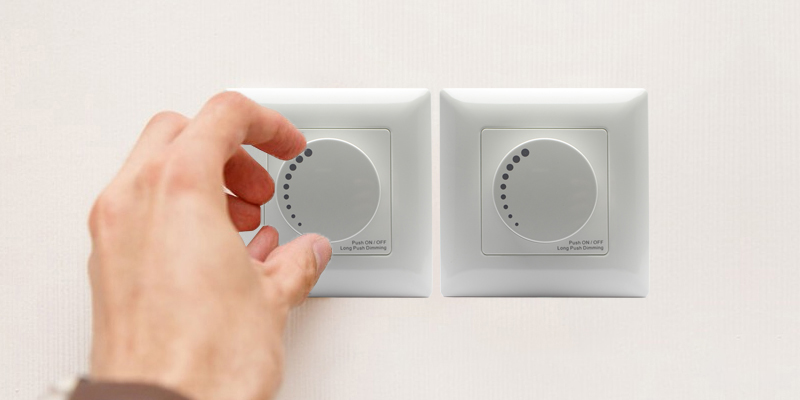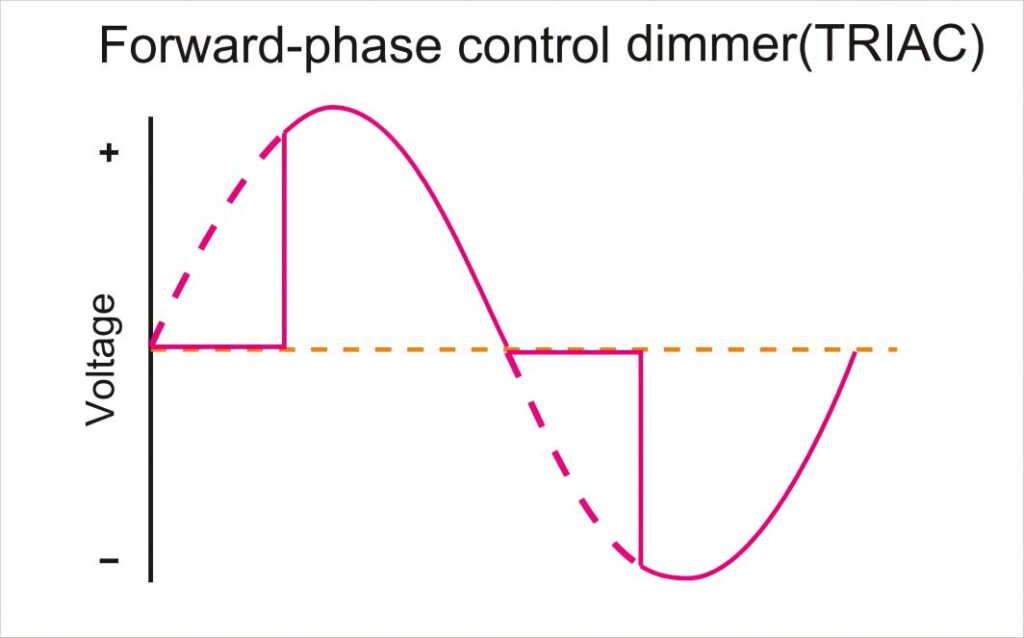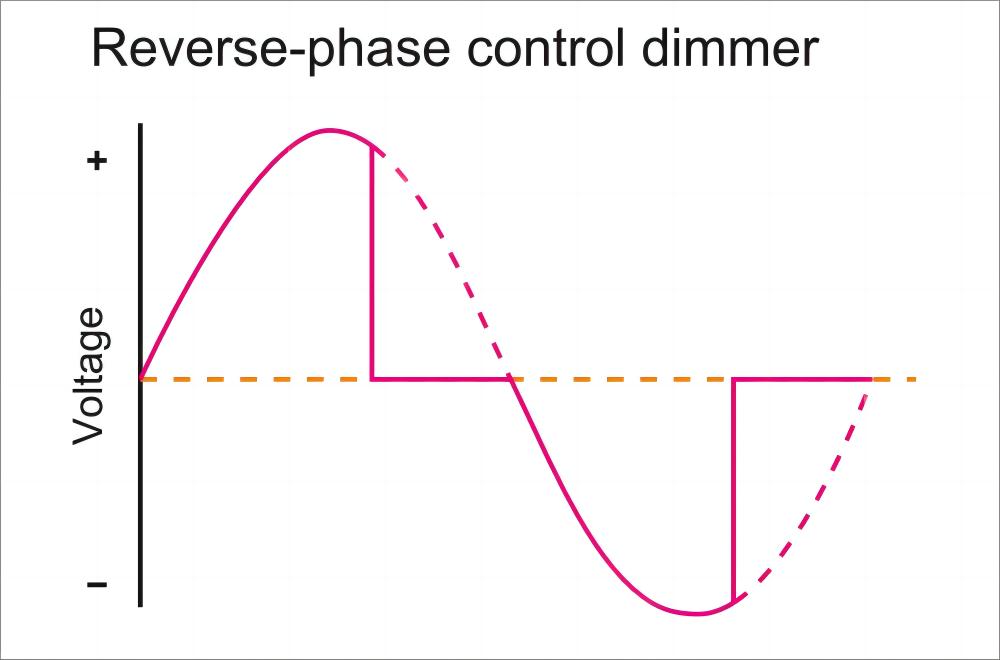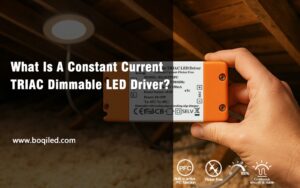조명 기술이 발전함에 따라 밝기 수준을 제어하는 기능은 주거 공간과 상업 공간 모두에서 필수적인 요소가 되었습니다. 조광기를 사용하면 조명을 유연하게 제어할 수 있어 원하는 분위기를 설정하고 에너지 효율을 높일 수 있습니다. 가장 인기 있는 조광기 유형 중 하나는 TRIAC 조광기. 경제성, 단순성, 기존 광원과의 호환성으로 잘 알려진 TRIAC 디머는 다양한 설정에 이상적입니다.

이 종합 가이드에서는 TRIAC 디머의 정의, 작동 방식, 다른 디밍 기술과 비교하는 방법을 설명합니다. 끝으로 TRIAC 디머의 장점과 한계, 그리고 조명 요구 사항에 적합한지 여부를 알게 될 것입니다.
TRIAC 디머는 조명에 공급되는 전력을 변조하여 조명 밝기를 제어하는 일종의 위상차 조광기입니다. 'TRIAC'은 '교류용 트라이오드'의 약자로, 교류(AC) 회로에 이상적인 반도체로 양방향으로 전류를 조절하기 때문에 주거용 및 상업용 디밍에 널리 사용됩니다.
트라이액 디머란 무엇인가요?
A TRIAC 조광기 ("교류용 트라이오드"의 줄임말)는 조명에 보내는 전력을 조정하여 빛의 강도를 제어하는 데 사용되는 전자 장치입니다. 트라이액 디머는 다음과 같은 형태입니다. 위상차 디밍 기술로, AC(교류) 파형의 일부를 차단하여 조명에 공급되는 에너지를 줄여 밝기를 제어합니다.

회로에 저항을 추가하여 단순히 전력을 줄이는 저항식 디머와 달리 TRIAC 디머는 각 AC 사이클 내의 다른 지점에서 전원을 빠르게 켜고 끄는 방식으로 작동합니다. 조명에 전력이 공급되는 시점을 제어함으로써 에너지 낭비 없이 밝기를 효과적으로 조절할 수 있습니다. TRIAC은 많은 주거용 및 소규모 상업용 디밍 애플리케이션, 특히 백열등과 할로겐 조명의 표준으로 자리 잡았습니다.
트라이액 디머의 구성 요소
TRIAC 디머는 일반적으로 몇 가지 핵심 구성 요소로 이루어져 있습니다:
- 사이리스터(TRIAC): 전력 흐름을 제어하는 핵심 구성 요소로, 회로 내에서 효과적으로 온-오프 스위치 역할을 합니다.
- 커패시터: 회로 내에서 타이밍을 조절하여 전원이 흘러야 하는 시기를 결정합니다.
- 전위차계: 이 구성 요소는 저항을 제어하여 전원이 공급되는 AC 사이클 내의 지점을 설정하여 밝기 레벨을 조정합니다.

이러한 구성 요소를 함께 사용하면 TRIAC 디머가 에너지 효율적인 방식으로 다양한 조도 레벨을 생성할 수 있습니다.
TRIAC 디머는 어떻게 작동하나요?
TRIAC 디머는 다음을 사용하여 작동합니다. 위상차 기술. 밝기를 자세히 제어하는 방법은 다음과 같습니다:
- AC 주기: 교류(AC) 회로에서 전압 파형은 초당 60회(북미) 또는 초당 50회(유럽) 양극과 음극 사이를 순환합니다. 이 일정한 변동이 TRIAC 디밍의 기초를 제공합니다.
- 위상 절단: TRIAC 디머는 연속적인 전기 흐름을 전달하는 대신 AC 파형의 일부를 "잘라냅니다". 파형의 일부를 차단함으로써 빛에 도달하는 전력의 양을 제어하여 조명을 어둡게 합니다.
- 최첨단 디밍: 대부분의 TRIAC 디머는 최첨단 디밍을 사용합니다. 즉, 각 AC 사이클이 시작될 때 전원을 끄고 사용자의 디밍 설정에 따라 결정된 지점에서 다시 전원을 켭니다. 파형이 더 많이 차단될수록 빛이 더 어두워집니다.

TRIAC 디머 스위치의 종류
TRIAC 디머는 다양한 사용 사례에 맞춰 다양한 디자인으로 제공됩니다:
- 로터리 디머: 주거 환경에서 흔히 볼 수 있는 이 조광기는 노브를 사용하여 밝기를 조절합니다.
- 슬라이드 디머: 가정과 사무실에서 자주 사용하는 조도 조절용 슬라이딩 스위치가 있습니다.
- 스마트 조광기: 스마트폰 또는 홈 자동화 시스템을 통해 제어되며, 스마트 홈 설정과 통합되어 편리함을 더합니다.
- 원격 디머: 무선 리모컨으로 작동하며, 넓은 공간이나 원격 액세스가 필요한 환경에 이상적입니다.
각 유형은 고유한 사용자 경험을 제공하지만, 모두 동일한 기본 TRIAC 기술을 기반으로 작동합니다.
TRIAC 디머의 애플리케이션
TRIAC 디머는 다용도로 사용할 수 있으며 다음과 같은 다양한 조명 애플리케이션에 적합합니다:
- 주거 공간: 트라이액 디머는 거실, 식당, 침실에서 편안한 조명을 연출할 수 있어 가정에서 인기가 높습니다. 집주인이 분위기를 제어할 수 있어 필요에 따라 공간을 더욱 편안하게 만들거나 활력을 불어넣을 수 있습니다.
- 상업 공간: 레스토랑, 소매점, 호텔과 같은 환경에서 TRIAC 디머를 사용하면 시간대나 이벤트에 따라 맞춤형 조명을 설정할 수 있습니다. 밝기 수준을 조정함으로써 비즈니스 소유자는 에너지 비용을 절감하고 고객에게 환영받는 환경을 제공할 수 있습니다.
- 산업 애플리케이션: 산업 환경에서는 흔하지 않지만 TRIAC 디머는 창고, 작업장 및 공장에서 조명을 제어하고 가시성을 개선하며 에너지 소비를 줄이는 데 사용할 수 있습니다.
- 엔터테인먼트 장소: 트리악 디머는 극장, 강당 및 기타 엔터테인먼트 공간에서 분위기를 조성하기 위해 정밀한 조명 제어가 필요한 곳에도 사용됩니다.
루트론 디머는 TRIAC 디머인가요?
Lutron 는 다양한 디머를 제공하는 잘 알려진 브랜드입니다. TRIAC 기반. 같은 모델 PD-6WCL 그리고 PD-10NXD 백열전구 및 할로겐 전구와의 호환성을 위해 TRIAC 기술을 활용합니다. 루트론 디머는 안정성과 설치 편의성으로 잘 알려져 있으며 주거용 및 상업용 조명 시스템 모두에 완벽하게 통합됩니다.
Lutron은 LED와 호환되는 디머도 생산하지만, 전력 요구 사항의 차이로 인해 모든 TRIAC 디머가 LED와 잘 작동하는 것은 아니라는 점에 유의해야 합니다. 항상 사용하려는 조명 유형과 특정 Lutron 디머의 호환성을 확인하세요.
트라이액 디머와 엘브이 디머의 차이점은 무엇인가요?
ELV(전자 저전압) 디머 를 통해 작동하는 또 다른 유형의 디머입니다. 역상 디밍. AC 사이클이 시작될 때 전원을 차단하는 TRIAC 디머와 달리 ELV 디머는 각 사이클이 끝날 때 전원을 차단합니다. 이 방식을 사용하면 빛의 전환이 더 부드러워지고 LED 드라이버의 마모가 줄어들어 ELV 디머가 LED와 더 잘 호환됩니다.
- TRIAC 디머: 백열등 및 할로겐 조명에 가장 적합하며 비용이 저렴하고 기술이 단순합니다.
- ELV 디머: 부드러운 디밍, 전력 서지 감소 및 효율성 향상을 제공하는 LED 조명에 이상적입니다.
ELV 디머는 LED 설정에 유리하지만, TRIAC 디머는 비용 효율성과 신뢰성으로 인해 기존 조명 유형에 여전히 인기가 있습니다.
TRIAC 디머는 리딩 엣지인가요, 트레일링 엣지인가요?
TRIAC 디머는 거의 항상 최첨단 조광기. 최첨단 디밍에서는 디머가 AC 파형이 시작될 때 전원을 차단합니다. 이 방법은 이러한 서지를 견딜 수 있는 백열등 및 할로겐 전구에 적합한 전류를 급격하게 공급합니다.
그러나 LED 조명의 경우 이러한 급증은 깜박임, 수명 단축 또는 최적의 디밍 성능 저하로 이어질 수 있습니다. LED는 다음과 같은 경우에 가장 잘 작동합니다. 트레일링 에지 또는 역상 디밍(ELV 디머에서 제공하는 역상 디밍)과는 호환되지 않으므로 항상 호환성을 확인해야 합니다.


디머가 트라이액인지 확인하는 방법
디머가 TRIAC 기반인지 확인하려면 다음 표시기를 찾아보세요:
- 제품 라벨 제작: 많은 제조업체가 포장에 "TRIAC" 또는 "최첨단"을 표시합니다.
- 호환성 정보: 제품 사양에는 호환 가능한 조명 유형이 명시되어 있는 경우가 많으며, TRIAC 디머는 일반적으로 백열등 또는 할로겐 조명을 나열하고 LED 호환성을 지정할 수 있습니다.
- 물리적 특성: TRIAC 디머는 기존 디밍 설정의 일반적인 노브 또는 슬라이드 작동을 위해 설계된 경우가 많습니다.
- 기술 사양: 온라인 제품 설명이나 매뉴얼에서 '페이즈 컷' 또는 '최첨단'과 같은 용어를 확인하세요.
TRIAC 디머의 장점
TRIAC 디머는 몇 가지 뚜렷한 장점을 제공합니다:
- 경제성: TRIAC 디머는 일반적으로 다른 디밍 기술보다 비용 효율적이기 때문에 다양한 예산에서 사용할 수 있습니다.
- 사용 편의성: 설치와 작동이 쉬워 DIY 애호가와 전문가 모두에게 적합합니다.
- 폭넓은 호환성: TRIAC 디머는 백열등 및 할로겐 조명과 잘 작동하여 기존 조명 설정에 부드러운 디밍을 제공합니다.
트라이액 디머의 단점
이러한 장점에도 불구하고 TRIAC 디머는 특히 LED 조명과 함께 사용할 때 한계가 있습니다:
- 소음: 일부 TRIAC 디머는 특히 낮은 레벨로 디밍할 때 약간의 윙윙거리거나 윙윙거리는 소리가 납니다.
- 호환성 문제: TRIAC 디머는 모든 LED와 범용적으로 호환되지 않으므로 깜박임이 발생하거나 디밍이 제한될 수 있습니다.
- 에너지 효율 향상: 백열등에서는 효율적이지만, TRIAC 디밍은 ELV나 PWM과 같은 다른 방식에 비해 LED에서는 에너지 효율이 떨어집니다.
다른 디밍 기술과의 비교
트라이액 디밍은 시중에 나와 있는 옵션 중 하나일 뿐입니다. 다른 인기 있는 방법과 비교하는 방법은 다음과 같습니다:
- PWM (펄스 폭 변조): LED 조명에 일반적으로 사용되는 PWM 디밍은 조명을 빠르게 켜고 끄는 방식으로 밝기를 조정하여 부드러운 전환과 높은 효율을 유지합니다.
- 0-10V 디밍: 상업 공간에서 자주 사용되는 0-10V 디밍은 LED 및 형광등을 안정적으로 디밍 제어할 수 있습니다.
- 디지털 제어 시스템(달리, DMX): 대규모 상업, 산업 및 엔터테인먼트 환경에서 일반적으로 사용되는 DALI(디지털 주소 지정이 가능한 조명 인터페이스) 및 DMX와 같은 고급 시스템을 통해 복잡한 조명 제어가 가능합니다.
고급 조명 시스템: DALI 및 DMX
달리 그리고 DMX 는 대규모 설치 또는 정밀한 프로그래밍이 가능한 조명이 필요한 곳에 적합한 디지털 조명 제어 시스템입니다. TRIAC 디밍보다 고급 제어 기능을 제공하여 사용자가 수많은 조명기구를 제어하고 색상을 조정하며 특정 조명 장면을 만들 수 있습니다.
이러한 시스템은 더 비싸고 복잡하지만 극장, 쇼핑몰, 고급 주거 프로젝트와 같은 공간에 이상적입니다.
필요에 맞는 조광기 선택하기
적절한 조광기를 선택하는 것은 조명 유형, 예산 및 공간에 따라 다릅니다. 다음은 간단한 가이드입니다:
- 백열등 및 할로겐 조명: 경제성과 사용 편의성을 위해 TRIAC 디머를 사용하세요.
- LED 조명: 호환성 문제를 방지하려면 ELV 또는 LED 전용 TRIAC 조광기를 선택하세요.
- 복잡한 설치: 고급 프로그래밍이 가능한 제어를 위해 DALI 또는 DMX 시스템을 고려하세요.
전문가와 상담하면 조명 유형 및 에너지 목표와의 호환성을 보장할 수도 있습니다.
디밍 기술의 미래 트렌드
의 등장으로 스마트 홈 그리고 IoT 기술조광 시스템은 빠르게 진화하고 있습니다. 스마트 디머는 홈 자동화 시스템과 통합하여 원격 및 프로그래밍이 가능한 제어가 가능합니다. 트라이액 디밍이 여전히 인기가 있지만, 디지털 제어 시스템과 앱 기반 디밍이 조명의 미래를 형성할 가능성이 높습니다.
결론
트라이액 디머는 가정과 소규모 비즈니스에서 조명을 제어할 수 있는 경제적이고 사용자 친화적인 솔루션입니다. 유연성, 에너지 절약, 다양한 기존 조명 유형과의 호환성을 제공합니다. 그러나 LED 기술과 스마트 홈 통합이 발전함에 따라 사용자는 더 나은 효율성과 적응성을 위해 대체 조광 솔루션을 고려할 수 있습니다.







